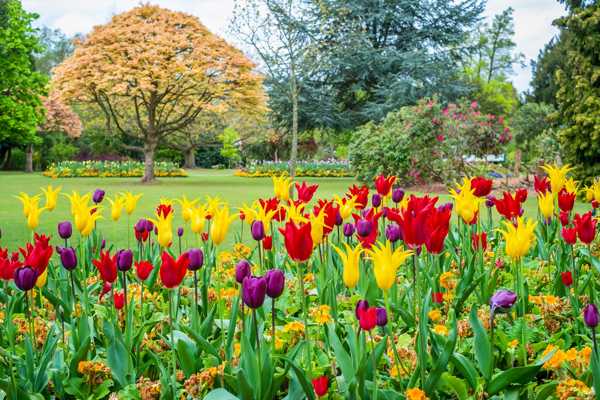County Durham contains a host of charming towns and villages outside of its beautiful county town. The region is steeped in religious and industrial history, with castles, cathedrals, and museums spread throughout. These feature unique art, artefacts, and displays showcasing the county’s rich mining and railway traditions.
The River Wear flows through the entire county, providing a dramatic coastal backdrop to the heather moorland of Durham. From its seaside to countryside villages, you’ll find historic structures, along with delightful cuisine and scenery. To make your tour of County Durham a memorable trip, we’re listing some of its picturesque villages below.
- 1
Brancepeth
Visit the stronghold of the Earls of Northern England

- Pasangan
- Sejarah
- Foto
Just 5 miles southwest of Durham is the 12th-century Brancepeth Castle, which is located in a village of the same name. In the castle grounds, you’ll find the towers owned by the Neville family during the Middle Ages, with the addition of the 18th-century grand country house of the coal mine-owning Russell family.
During the First World War, the castle served as a hospital for wounded soldiers. Today, the Quartermaster’s room is open for rent as a holiday flat. Just beside the castle is St Brandon's Church, which holds a wide collection of medieval grave slabs.
Petafoto oleh Stanley Howe (CC BY-SA 2.0) diubah suai
- 2
Gainford
Relax in a peaceful village that overlooks River Tees

- Pasangan
- Sejarah
- Foto
Gainford sits on the north bank of River Tees and was once an active thoroughfare for coal and steel shipments during the Industrial Revolution. You can walk along a footpath featuring a viewing platform and a sundial built to celebrate the new millennium in the year 2000. Along the river's bank is a sulphur spring called Gainford Spa, which is popular because of claims that its water has healing properties.
Extend your walking tour to the 13th-century St. Mary's Church and Gainford's pristine village green surrounded by Georgian townhouses. You can also drop by the 17th-century Gainford Hall manor house, Cross Keys Pub, and Academy Theatre where well-known comic Stan Laurel studied.
Petafoto oleh Gordon Hatton (CC BY-SA 2.0) diubah suai
- 3
West Auckland
Get a glimpse of the lifestyles of the Prince Bishops

- Pasangan
- Sejarah
- Foto
West Auckland, encircled by 17th- to 18th-century buildings, has one of the county’s widest village greens. Its most famous landmark is Auckland Castle, one of the best-preserved bishop's palaces in Europe. It has been occupied by the Prince Bishops of Durham for nearly 900 years. The British monarchy had tasked these prince bishops to repel Scottish invasions.
After its refurbishment, Auckland Castle opened the bishops' former quarters to the public. The castle's St. Peter's Chapel, one of the largest in Europe, houses intricate interiors and stained glass windows.
Peta - 4
Beamish
Go back in time as you step foot inside England's largest open-air museum

- Keluarga
- Sejarah
- Foto
Occupying about 300 acres of countryside, Beamish is a village that lies just northeast of Stanley. It’s dubbed as the Living Museum of the North, where 19th- and 20th-century North England comes alive. When you visit the area, you’ll find translocated and replica buildings and shops, as well as costumed staff. Its tram and old vehicles complete the picture of what daily life was like in the region.
The museum is divided into several sections. First, there’s Pockerley Manor, built in the 1820s, which features the Waggonway steam train. Second, there’s the 1900s Colliery, where visitors can walk through a real drift mine. And finally, you can go to the Farm, which depicts life during the Second World War.
Petafoto oleh Steve Fareham (CC BY-SA 2.0) diubah suai
- 5
Teesdale
Castles, museums and scenery await you in Durham's southernmost dale

- Bajet
- Sejarah
- Foto
Explore Teesdale on foot starting from Barnard Castle, fondly called "Barney”. The remaining castle ruins include a 3-storey keep, the great hall built in the 14th century, and a tower.
Meanwhile, you can admire the paintings of European masters and other decorative art pieces at the 19th-century Bowes Museum. Built like a French chateau, the museum’s top attraction is a clockwork-driven Silver Swan music box. Lastly, complete your trip to Teesdale when you drop by England’s largest waterfall, the High Force.
Peta - 6
Castle Eden
Tour the North East's largest series of dense woodland valleys

- Sejarah
- Foto
Castle Eden is known for its 550-acre nature reserve, also referred to as the Dene. The reserve contains 10,000 years of wildwood growth – yew, oak, ash, and dying elm. Its deep gorge has provided a habitat for 450 species of plants, birds, roe deer, and foxes. A watercourse known as Eden Burn – where the village got its name – runs through the Dene.
In Castle Eden, you’ll find The Castle, a 3-level building made in the mid-1700s with battlement walls in front. Visitors can book any of The Castle’s en-suite rooms. Aside from its picturesque structures and nature’s wonders, people also flocked to Castle Eden for its ale.
Petafoto oleh Ben Brooksbank (CC BY-SA 2.0) diubah suai
- 7
Staindrop
Learn about medieval aristocratic living on the Neville estate

- Sejarah
- Foto
Staindrop’s development was influenced by the powerful Neville family, who produced 2 English kings. This included the construction of both Raby Castle and St. Mary's Church. Built in the 1300s, the Raby stands on an 200-acre lush deer park. The castle has a 5-acre walled garden, a collection of horse-drawn carriages, and a rustic children's obstacle course called Woodland Adventure Playground. Its interiors house 17th- to 20th-century art, textiles, furniture, and copper cooking utensils.
You’ll find the Nevilles’ gravestones on the grounds of St. Mary's, which also keeps the memorabilia of village residents who served in the 2 World Wars. Costumed children, floats, and vehicles go on a parade during the annual Staindrop Carnival.
Petafoto oleh Jo Turner (CC BY-SA 2.0) diubah suai
- 8
Tanfield
Hop on the world's oldest working railway in this former mining village

- Sejarah
- Foto
Coal mining was the primary industry of Tanfield in the 18th to 19th centuries. That led to the establishment of the Tanfield Railway, which brought coal to waiting collier ships on the River Tyne. The route had been operational for over 200 years until 1964. Here, you can find the Causey Arch, the world's oldest surviving single-arch railway bridge. You can also take a steam train on this railway on Sundays for a 3-mile sightseeing tour of Causey Valley.
The local St. Margaret's Parish was built in the mid-12th century, but villagers may have built an earlier community church on the same site as early as AD 900.
Peta - 9
Aycliffe Village
See how a business park sprang from this former small arms-making village

- Sejarah
- Foto
Aycliffe was instrumental in the defence against the Luftwaffe bombing raids of the Second World War. The village hosted a top-secret factory making bullets, munitions, and detonators, working 24/7 in 3 shifts. Around 17,000 people made up the workforce at the Royal Ordnance Factory or ROF 59. The workers were later referred to as the "Aycliffe Angels".
On the factory site now stands the Newton Aycliffe Industrial Estate. It’s one of the UK's leading business parks, where over 10,000 people work for more than 500 firms.
Petafoto oleh Dave Kelly (CC BY-SA 2.0) diubah suai
- 10
Summerhouse
Tickle your taste buds at the North East’s lone 2-Michelin star restaurant

- Makanan
- Foto
Summerhouse used to be a generally quiet and unknown rural hamlet until British golfer-turned-chef James Close and his family acquired an 1899-built real ale pub. After Close renamed it the Raby Hunt, the pub soon won the first Michelin star for the North East in 2013, with the second added just 4 years later. Sample the restaurant's specialties such as chutoro tuna with white truffle, wagyu with smoked aubergine, and its iconic chocolate skulls.
Other than the pub, Summerhouse is a quiet, peaceful and extremely small place. Its population is barely measured in the hundreds and houses are mostly old stone constructions or modern imitations.
Petafoto oleh Stanley Howe (CC BY-SA 2.0) diubah suai



















